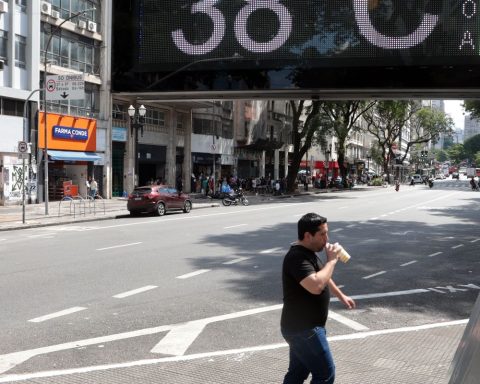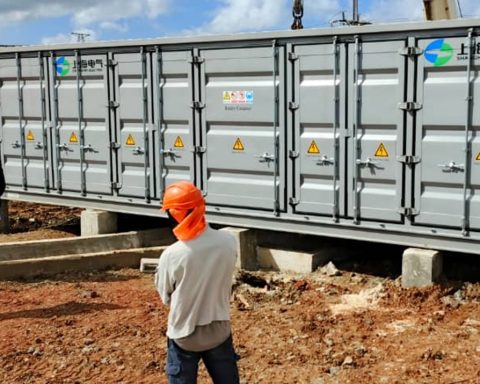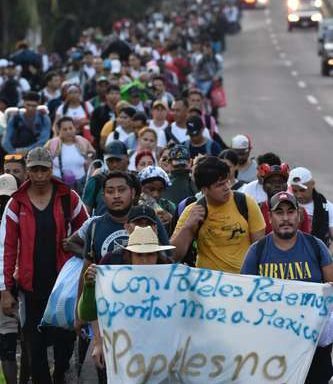In January 2018, the basic monthly basket in Nicaragua had a total cost of C$13,396.89 córdobas ($368.35 US dollars at current exchange rates). At that time, in the Central American country, a pound of rice cost C$12.78 córdobas (US$0.35 dollars) and the same unit of beans had a price of C$16.26 córdobas ($0.45 dollars).
As of November 2022, the total price of the basic monthly basket increased to C$18,845.78 córdobas, that is to say US$518.17 dollars. It costs C$5,448.89 córdobas more (a little more than the equivalent of a minimum wage), and a pound of rice and beans was already hovering at C$17.20 and C$37.46 córdobas, respectively.
In other words, between January 2018 and November 2022, the basic monthly basket in Nicaragua increased 40.67%and 36 of the 53 products and services that make it up registered increases in their prices during said period, mainly basic foods, meats, dairy products, cereals, perishables, and products for household use.
Since 2018, according to consumers in two neighborhoods and two capital markets, prices have increased evenly, as the regime of Daniel Ortega and Rosario Murillo has detailed in the monthly reports published by the National Institute of Development Information (INIDE), although in some places even more than what is reported in the official figures.
Of the basic services, butane gas and electricity increased their costs as of November 2022, while rent, drinking water and public transportation have maintained their prices since 2018, according to the Sandinista administration.
A 25-pound butane gas tank, for example, used in most homes in the capital for cooking, went from being worth C$315.75 córdobas in January 2018 to C$436 córdobas in November 2022; registers an increase of 38.08%.
Meanwhile, a KWH of electricity now costs 16.73% more, from C$2.75 córdobas in January 2018 to C$3.21 córdobas in November 2022.
Food suffers the greatest impact
“Kelly”, whom we will call that for her safety, comments that during the last week of December a pound of rice in two of the stores in her neighborhood in downtown Managua already cost C$18 and C$20 córdobas. “The most expensive is the one with the most whole grain,” comments this single mother, who assures that she does not receive a salary of at least half of the total basic food basket.
He also comments that other products such as beans, oil, poultry meat, fish cutlets, milk, cheese, tomato, potatoes, and soaps or detergent showed an increase throughout 2022, and since 2018. “Back then you could find a tortilla a peso (C$1 córdoba) or a pound of cheese at 80. Now it is an impossible mission to stretch the C$8,000 córdobas that I am still fortunate to receive,” explains the 30-year-old, who must pay rent and her health insurance.
Only in food, the INIDE registers a monthly expense of C$13,421.42 córdobas as of November 2022, with products that since 2018 have increased between 20% and 130%.
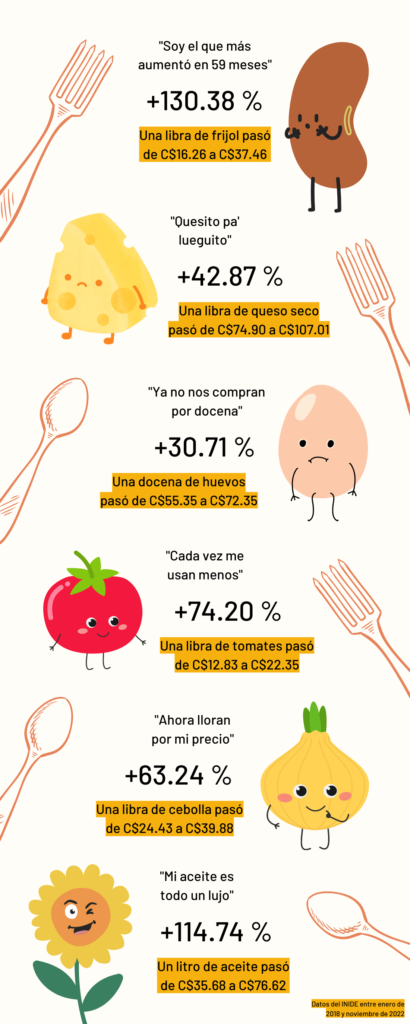
Now that beans are 130.38% more expensive than in January 2018, Kelly makes less gallopinto (a dish that mixes rice and fried beans), and even eats less meat “for future health reasons and for the real privilege that comes with it.” spend on it.” “Even having a coffee with milk at home is now a luxury. Or for the sugar, or for the milk, or for the bread that accompanies it,” adds the citizen.
Of all the categories and products included in the basic monthly basket, those classified in clothing were the ones that showed the smallest increases. On the other hand, products for home use went from a total of C$2,873.66 córdobas in January 2018 to C$3,499.51 córdobas in November 2022. That is, now 21.78% more money is required to have a place to live and to maintain clean said space.
inflation does not subside
The lowest interannual inflation registered in Nicaragua since January 2012 was that of November 2015, with 2.0%, while the highest were those of August and October 2022, with 12.15% and 12.16%, respectively.
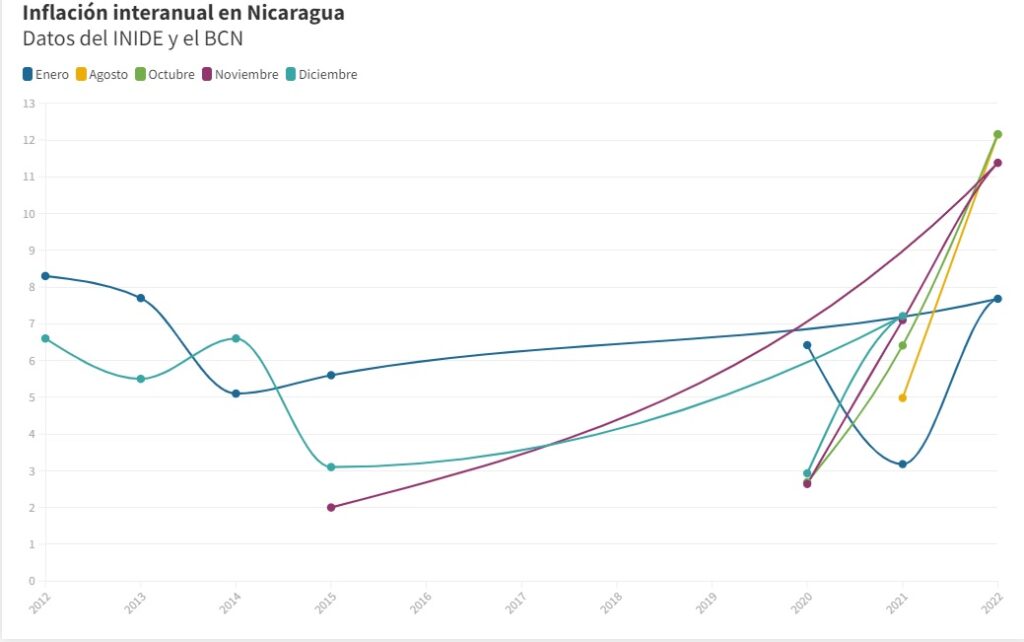
According to the Consumer Price Index (CPI) for the month of November 2022, prepared by the official INIDE, accumulated inflation in Nicaragua was 9.83% until then, while interannual inflation reached 11.38%, one of the highest reported by said institution since January 2018, coinciding even with data from the Central Bank of Nicaragua (BCN).
According to official figures, Nicaragua registers the lowest minimum wage in Central America, between C$4,414.91 and C$9,880.17 córdobas, which correspond to $121 and $271 US dollars. In addition, the nation has the highest energy tariff in the Central American region, as well as the highest fuel price.
Related news: BCN affirms that the Nicaraguan economy will grow by 3 or 4% in 2023
Regarding unemployment, according to INIDE, as of November 2022 “the participation of the labor force at the national level was 67.2%, decreasing by 0.6 percentage points compared to November 2021 (67.8%), and increasing by 0.8 percentage points compared to the previous month.
«Squeeze our income just to eat»
For Carlos Martínez, a merchant from the Oriental market, located north of Managua, the above figures do not make much sense, because in reality “on the street and here in the market things are more expensive, even clothes, but what else Can be done? People do not put those prices per dwelling. Actually everything is expensive.
Kelly thinks the same. She points out that in the grocery stores where she usually buys, “due to her lack of time”, the prices “are regulated by themselves”, as an effect of the “uniform increase”. “I tried to buy cheaper things in wholesale supermarkets but up to that point you find crazy prices, but they are high,” says the woman.
Related news: Increase in remittances reflects the “inability to survive” in Nicaragua
For his part, Martínez points out that the very precarious salaries that the country has are spent only on food. “We have to squeeze our income just to eat. The salary is no longer enough, which is miserable. You have to manage to make ends meet, and even then the only objective is not to stop eating”.
Christmas and New Year’s Eve dinners in 2022 were marked by this increase in prices, and these increases will continue during 2023 for various reasons, including the war in Ukraine due to the Russian invasion, the loss of production force due to migration and other local or global increases.
In addition, regional experts have declared to independent media that “the Nicaraguan economy is not providing enough resources for citizens.” “Growth of 4% (estimated for Nicaragua by the World Bank and the BCN in 2022) and possibly 2.5% in 2023 is not enough to satisfy needs, much less to generate wealth,” said Manuel Orozco of the Inter-American Dialogue. voice of america.
By: United Voices.














